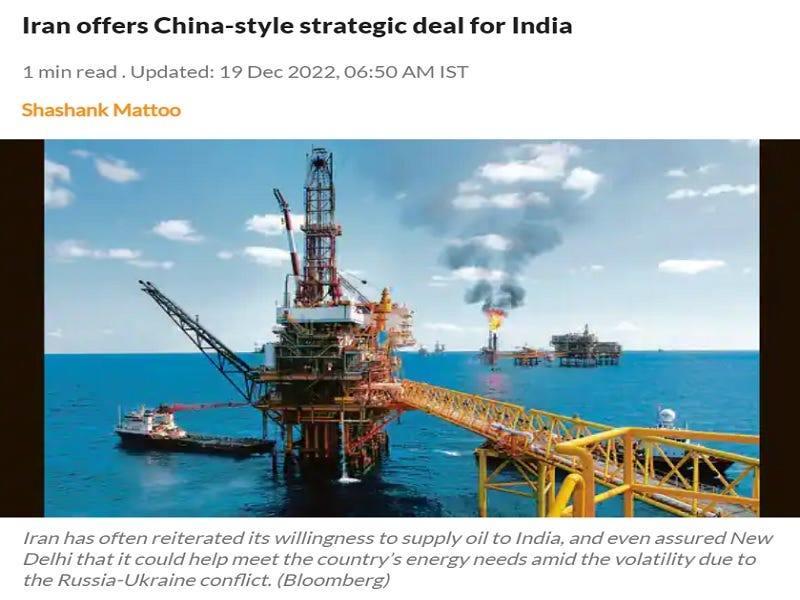Analyzing Iran’s Reported Offer Of A China-Style Strategic Partnership With India
Although the Indian-Iranian Strategic Partnership proposal reportedly predated China’s unintentional diplomatic violation of Iran’s legitimate national interests by several weeks, the fiercely anti-Iranian joint statement that China recently agreed to with the GCC might have prompted Iranian officials to encourage their Indian ones to leak their plans to the press at this particular time.
Mint just reported that Iranian Deputy Foreign Minister Ali Bagheri Kani offered India a China-style strategic partnership during his trip to Delhi last month. Mehr News Agency indicated at the time that he did indeed discuss comprehensively expanding bilateral cooperation, which adds credence to what Mint just wrote citing two unnamed people who are allegedly aware of the matter. Considering their reinvigorated cooperation on the North-South Transport Corridor (NSTC) this year, it might be true.
That decade-long project previously failed to reach its potential owing to a wide variety of reasons, but it was given a second life after the US-led West’s Golden Billion imposed the strictest sanctions in history on Russia in response to Moscow’s special operation in Ukraine. The NSTC resultantly became that Eurasian Great Power’s only viable international logistics corridor, which in turn prompted closer trilateral cooperation between them and accelerated their grand strategic convergence.
Russia, India, and Iran are now jointly trying to create a third pole of influence for breaking through the present bi-multipolar impasse in International Relations that’s characterized by the Sino-American superpower duopoly exercising disproportionate sway over global affairs. As Russia’s strategic ties with its two partners tighten, it therefore naturally follows that Indian-Iranian relations will inevitably do so as well due to the mutually beneficial reasons inherent in this scenario.
For starters, the NSTC is the core of their collective efforts to pioneer a new multipolar corridor through the heart of Eurasia in order to revolutionize International Relations as was explained. Second, progress in this respect will also unlock India’s potential for balancing China’s growing influence in Afghanistan and Central Asia via economic means. Third, Iran itself also aspires to balance China in a friendly, gentle, and non-hostile way, ergo its desire to clinch a complementary strategic partnership with India.
The last-mentioned observation was given a fresh impetus after the People’s Republic unintentionally violated its Islamic counterpart’s legitimate national interests by agreeing to a fiercely anti-Iranian joint statement with the GCC. Although the Indian-Iranian Strategic Partnership proposal reportedly predated that diplomatic development by several weeks, President Xi’s signature on that scandalous document might have prompted Iranian officials to encourage their Indian ones to leak their plans to the press.
Moving along and building upon the preceding insight, the fourth point is that Indian industrial and infrastructure investments in Iran might have a quicker return on investment than Chinese ones owing to those two’s geographic proximity that’ll reduce transport costs. Similarly, by playing Chinese and Indian investors off against one another, Iran can more confidently secure the deals that are best suited for its interests instead of agreeing to whatever Beijing suggests due to an absence of choice.
And finally, the last argument in support of a China-style Indian-Iranian Strategic Partnership is that its related energy dimension would preemptively avert Tehran’s potentially disproportionate dependence on China as its top Asian customer simultaneously with ensuring Delhi’s long-term energy security. The first motivation aligns with the Islamic Republic’s multipolar balancing act while the second would provide India with more cheap energy upon which to further turbocharge is already rapid development.
With these five mutually beneficial reasons in mind, there’s no reason to doubt Mint’s latest report that Iran offered India a China-style strategic partnership during its Deputy Foreign Minister’s visit to Delhi last month. It makes perfect sense from the perspective of their bilateral relations as well as their growing trilateral ties with Russia. The successful clinching of such a deal would further accelerate the global systemic transition to multipolarity and therefore be in the interests of everyone.




